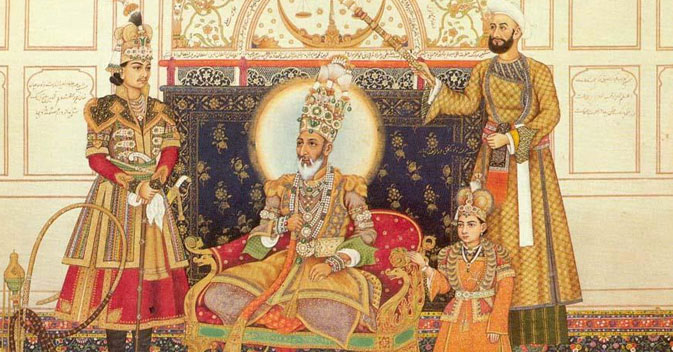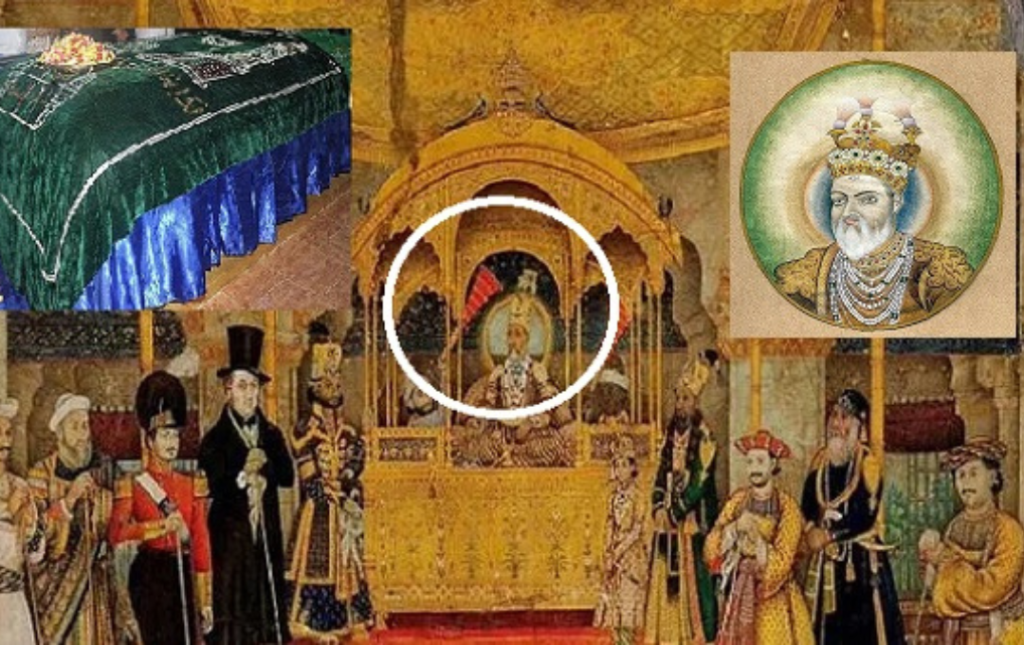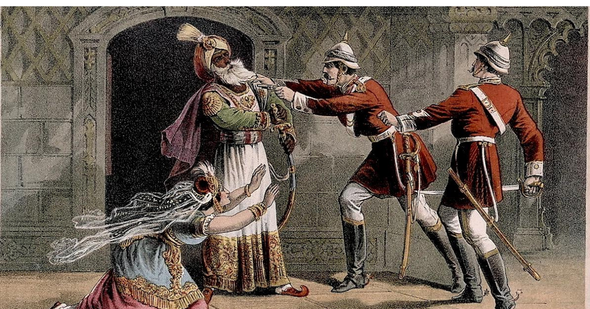Last Updated on September 6, 2023 by Manu Bhai
Introduction Of Bahadur Shah Zafar
- Who was BahadurShah Zafar?
- The significance of Bahadur Shah Zafar in Indian history
- The purpose of the article
- Bahadur Shah Zafar Biography
Who was Bahadur Shah Zafar?
Bahadur Shah Zafar was the last Mughal emperor of India when he ascended to the throne in 1837 at the age of 62. He ruled a turbulent period in Indian history as the British East India Company gradually consolidated its control over the Indian subcontinent. Bahadur Shah Zafar’s reign brought profound changes to India’s political, economic, and cultural landscape, culminating in the Indian Rebellion of 1857. This article details the life, administration, and legacy of Bahadur Shah.
The significance of Bahadur Shah Zafar in Indian history
Indian soldiers who had rebelled against the East India Company in Meerut in 1857 arrived at the Red Fort in Delhi on May 1, 1857. He held court on his 12th May, made various appointments, and declared war on England. He later established the GrandCouncilon Administrative Affairs and assigned different duties to different people based on their ability and loyalty, regardless of religion.
In 1857, a rebellion broke out in India against British rule, known as the Indian Rebellion of 1857 or the First War of Indian Independence. Bahadur Shah Zafar was proclaimed the emperor of India during the rebellion, and his call for a united front against the British was significant. However, the rebellion was ultimately unsuccessful, and the British exiled him to Rangoon (now Yangon, Myanmar).
Early Life and Family Of Bahadur Shah Zafar
- Birth and upbringing of BahadurShah Zafar
- Family background and lineage
- Education and intellectual pursuits
Bahadur Shah Zafar, the last Mughal emperor, fought the First War of Independence and is historically recognized as a symbol of the Indian public’s anger against the British. He was born on October 24, 1775. His father Akbar Shah II was the 14th Mughal emperor and his mother was Lalbai. He was the second son of Akbar Shah II and was educated in Arabic and Persian by renowned scholars of his time.
Bahadur Shah Zafar was a patron of the arts and he had a keen interest in equally poetry and music. He also like to write poetry himself as he wrote several poems under the pen name Zafar and supported many poets and musicians. His patronage had a significant impact on Urdu literature and music.
Bahadur Shah Zafar was married three times and had several wives and concubines. Three sons and four girls were among the many children he had with his first wife, Kudia Begum. His descendants were significant figures in Indian history, particularly during the struggle for freedom.

Ascension to the Throne
- Circumstances leading to Bahadur Shah Zafar’s coronation
- Challenges faced by Bahadur Shah as the Mughal Emperor
- The political climate of India during Bahadur Shah Zafar’s reign
After his father passed away in 1837, at the age of 62, took the throne. He did, however, experience several difficulties, such as political and financial turmoil. He made an effort to keep control of his realm, over which the British East India Company had ceremonial power.
Challenges faced by Bahadur Shah Zafar
Bahadur Shah Zafar, the last emperor of the Mughal Empire in India, had to deal with a lot of challenges. Here are a few of the main challenges he had to Face:
Political instability: Bahadur Shah took over as emperor of the Mughal Empire at a time when it was in a state of collapse. He had to deal with numerous in-empire uprisings and power disputes. As a result, he had to invest a lot of time and money into upholding his position of power.
Economic Crisis: The British East India Company dominated much of India’s trade and commerce, which contributed to the decline of the Mughal Empire’s economy. This caused budgetary issues and left the emperor without the tools necessary to perform his administrative responsibilities.

Religious Tensions: The Mughal Empire was a Muslim dynasty ruling over on predominantly Hindu population. Bahadur Shah Zafar faced tensions and conflicts between the two religious communities, which were exploited by his enemies to undermine his rule.
International Pressure: The decline of the Mughal Empire had drawn the attention of other global powers, including the British, French, and Russians. Bahadur Shah had to navigate the complex political landscape of competing interests and alliances to maintain his position as the emperor.
Despite these challenges, Bahadur Shah Zafar is remembered for his contributions to Indian culture and literature. His reign marked a period of cultural renaissance in India, particularly in the field of Urdu literature and music. While his rule may have been fraught with challenges, his legacy continues to inspire and influence people to this day.
Read Also:
Mahatma Gandhi Life’s Facts | महात्मा गाँधी के जीवन से जुड़ी रोचक तथ्य जिन्हे आप नहीं जानते
इतिहास में खजुराहो मंदिर का महत्त्व Importance of Khajuraho temples History
Bahadur Shah Zafar’s Administration
- Overview of Bahadur Shah Zafar’s governance
- Economic policies and achievements
- Judicial reforms and administrative changes
Despite the Challenges he encountered, Bahadur Shah Zafar was able to carry out a number of important economic and governmental changes throughout his rule. He lowered agricultural tariffs, aided the growth of new businesses, and promoted international trade. He improved the effectiveness of the bureaucracy and overhauled the legal system as well.
Economic policies and achievements
Bahadur Shah Zafar faced significant economic challenges during his rule as the last emperor of the Mughal Empire in India. Despite this, he has implemented several economic policies that aimed to improve the Mughal empire’s financial situation. One of his markable achievements was the establishment of a new currency system that helped stabilize the Financial economy.
He also took steps to promote trade and commerce, such as reducing taxes on goods and improving the infrastructure for transportation. Additionally, Bahadur Shah Zafar supported the arts and literature, which contributed to a cultural renaissance in India during his reign. These economic policies and achievements, though limited, reflect his efforts to address the economic challenges facing the Mughal Empire at the time.
Judicial reforms and administrative changes
Bahadur Shah Zafar, the last Mughal Emperor, introduced several judicial reforms and administrative changes during his reign. These changes aimed to improve the functioning of the Mughal administration and provide better justice to the people.
One of his notable reforms was the establishment of a separate department for justice, which helped to streamline the judicial process. He also introduced new laws and regulations that helped to protect the rights of the people and ensured fair treatment for all.
In terms of administrative changes, he made efforts to modernize the Mughal administration by introducing new administrative structures and departments. He appointed competent and efficient officials to key positions and tried to reduce corruption in the administration.
Additionally, he made efforts to improve infrastructure and public services, such as building new roads, canals, and hospitals. These administrative changes helped to improve the standard of living for the people and strengthen the Mughal administration.
Overall, Bahadur Shah Zafar’s judicial reforms and administrative changes reflect his commitment to improving the governance of the Mughal Empire and ensuring justice and prosperity for its people.

Bahadur Shah Zafar and the Indian Rebellion of 1857
The Indian Rebellion of 1857, also known as the First War of Indian Independence, was a significant event during Bahadur Shah Zafar’s reign. The rebellion was a result of various factors, including the Indian soldiers’ resentment towards the British East India Company, the imposition of Western culture, and the company’s economic exploitation of India.
Bahadur Shah Zafar played a significant role in the rebellion, and many of the rebels saw him as a symbol of Indian nationalism. He was proclaimed as the emperor of India during the rebellion, and his call for a united front against the British was significant. However, the rebellion was ultimately unsuccessful, and Bahadur Shah was exiled to Rangoon (now Yangon, Myanmar) by the British.
Read Also:
Ranakpur Jain Temple: Timing, History, and Architecture Of Ranakpur Jain Temple

Exile and Death
- Bahadur Shah Zafar’s exile to Rangoon
- Bahadur Shah’s death and legacy
The last few years of Emperor Bahadur Shah Zafar’s life were spent in exile in Rangoon in Myanmar, where he passed away in prison in 1862 at the age of 87. As writing poetry was one of his main hobbies, So he kept on writing poems and had a big impact on Urdu literature. His cemetery in Rangoon, where he was buried, has become a popular destination for Indian pilgrims. He will always be remembered as a Great Freedom Fighter as well as a good king.
Bahadur Shah Zafar’s death and legacy
Tragically, Bahadur Shah Zafar’s reign as the final Mughal emperor came to an end when the British seized him following the Indian Rebellion of 1857. Along with his family, he and they were deported to Rangoon (now Yangon), in Burma (now Myanmar), where he passed away in 1862.
Bahadur Shah Zafar’s imprint endures in Indian history and culture despite his relatively brief and turbulent reign. He is remembered for his efforts to better the Mughal Empire’s administrative and economic systems as well as for his contributions to the arts and literature. His poetry in particular, including his Ghazals and Nazms, which are revered as examples of his literary talent and cultural impact, has emerged as a permanent icon of his legacy.
Family of Bahadur Shah Zafar
- Wives and children of Bahadur Shah Zafar
- Descendants of Bahadur Shah Zafar
Bahadur Shah Zafar, the last Mughal Emperor, had a large family consisting of several wives and children. He had four wives, each of whom had children.
His first wife was Begum Ashraf Mahal, with whom he had three sons named Mirza Fath-ul-Mulk Bahadur, Mirza Khizr Sultan, and Mirza Abu Bakr. He also had a daughter named Fakhr un-Nissa from this marriage.
His second wife was Begum Akhtar Mahal, who gave birth to two sons named Mirza Mughal and Mirza Khurshid Jah, as well as a daughter named Zeenat Mahal.

Bahadur Shah Zafar’s third wife was Begum Zeenat Mahal, who had one son named Mirza Jawan Bakht.
Finally, his fourth wife was Begum Taj Mahal, who gave birth to a daughter named Taj Mahal Begum.
Overall, Bahadur Shah Zafar’s family was a significant part of his life and legacy, with several of his descendants going on to play important roles in Indian history and culture.
Bahadur Shah Zafar’s Cultural Contributions
Bahadur Shah Zafar was a patron of the arts and had a huge passion for music and poetry. He always encouraged several poets and musicians in India and published a number of poems under the pseudonym Zafar. His support had a big influence on Urdu music and writing.
FAQs (Frequently Asked Questions)
- Who was Bahadur Shah Zafar?
Bahadur Shah Zafar was the last Mughal emperor who ruled India from 1837 to 1857.
- What was Bahadur Shah Zafar’s role in the Indian Rebellion of 1857?
Bahadur Shah Zafar played a significant role in the Indian Rebellion of 1857, also known as the First War of Indian Independence. He was proclaimed as the emperor of India during the rebellion, and his call for a united front against the British was significant.
- What were Bahadur Shah Zafar’s cultural contributions?
Bahadur Shah Zafar was a patron of the arts and had a keen interest in poetry and music. He wrote several poems under the pen name Zafar and supported many poets and musicians. His patronage had a significant impact on Urdu literature and music.
- What happened to Bahadur Shah Zafar after the Indian Rebellion of 1857?
After the Indian Rebellion of 1857, Bahadur Shah was exiled to Rangoon (now Yangon, Myanmar) by the British. He spent the last years of his life in exile and died there in 1862.
- What is Bahadur Shah Zafar’s legacy?
Bahadur Shah Zafar is remembered as a significant figure in Indian history, particularly during the Indian independence movement. His contributions to Indian culture and literature are still celebrated today, and his poetry is widely read and appreciated. Several memorials and tributes exist in his honor, including the Bahadur Shah Zafar Marg in Delhi and the Bahadur Shah Zafar Park in Karachi.
Conclusion
The last Mughal emperor, Bahadur Shah Zafar, was a prominent figure in Indian history. The Mughal Empire was in decline throughout his reign, and he had to deal with multiple challenges. He is remembered, however, for his cultural accomplishments, particularly in the areas of Urdu music and writing. His involvement in the Indian Rebellion of 1857 had a big effect on Indian history and the cause for Indian independence. Even though he passed away distant from his native country and spent his final years in exile, his legacy has inspired and influenced others ever since. In Indian history and culture, Bahadur Shah Zafar is still regarded as a significant and adored figure.
